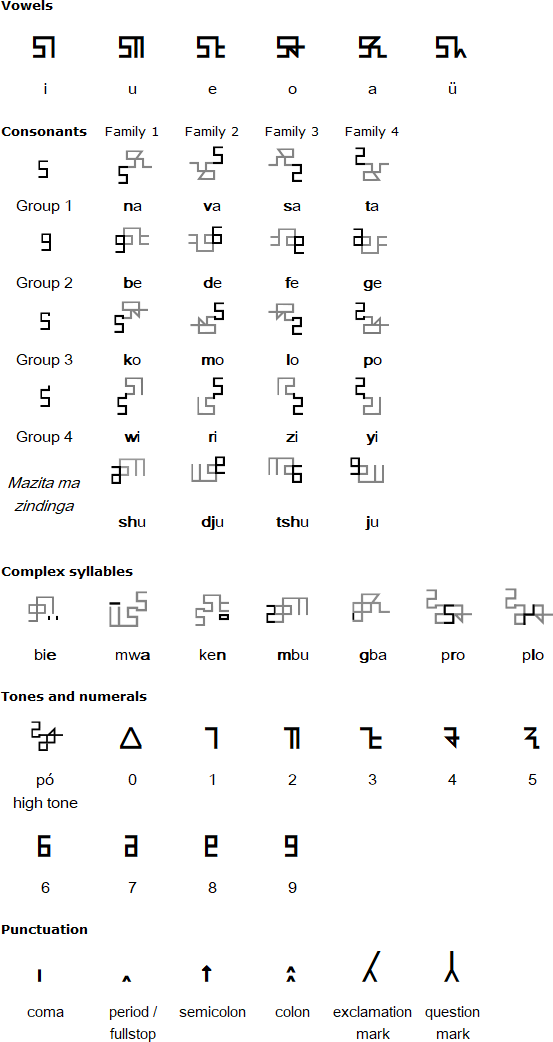Some have called it the only writing system in the world that looks like a brick wall. Indeed, among the many indigenous African languages, it has an outstanding appearance, and this is largely due to it being based on two shapes seen to be sacred that look like 2 and 5. What’s more, though the script is read from left to right, it can also be read from top to bottom, thus making it “the most advanced African script available on the continent South of the Sahara.”
David Wabeladio Payi, from the Democratic Republic of the Congo (DRC), invented the writing system in 1978. Today, the powerful script is used by thousands of people in Africa, Europe and the Americas.
Payi, then a member of the Kimbanguist Church — an indigenous Zairian religion — said the script was revealed to him in a dream where he saw two figures formed by mortar joints on his wall. The figures he saw on the joints looked like the digital numbers 2 and 5 that one can find in some electronic devices. Out of these two figures/shapes, the new script, “Mandombe”, was born.
“Mandombe” means “that which is Black” in the Kongo or Kikongo language, a Bantu language widely spoken in the Republic of the Congo, the Democratic Republic of the Congo, Angola, and some Central African nations. As a matter of fact, the Mandombe script can be used to transcribe languages such as Kikongo, Lingala, Swahili and Tshiluba, and other Bantu languages in West, Central, East, and Southern Africa, a report noted.
Four years after the writing system was invented, Payi was granted a patent for his script by the Ministry of Industry and Trade of the then Republic of Zaïre (now the DRC). It then took 12 years before the writing system was officially presented to the general public. Payi’s original idea was to use the script to write religious texts in the national languages of the Congo including the Lingala, Kikongo, Tshiluba and Swahili. However, the script was widely received such that it is now being taught in schools run by the Kimbanguist church in Angola, the Republic of the Congo, and the Democratic Republic of the Congo, as well as, Kimbanguist centers overseas including Belgium and France. A Kimbanguist organization known as the Centre de l’Écriture Négro-Africaine (CENA) has also been promoting the alphabet through various initiatives. The Centre is hopeful that the script will in the future be used to write all African languages.
Payi, before his death on April 4, 2013, in Turkey, taught the script to thousands of students at the Kimbanguist University in Kinshasa, the capital of the Democratic Republic of the Congo, where he was given a professorship. In 2011, he was granted the honorary title Doctor Honoris Causa, at the University of Kinshasa for developing Mandombe. He went on to teach the script in Kimbanguist church schools not only in Africa but also in the overseas centers — Belgium and France — before he passed away at 56 in Turkey where he had gone to seek medical care.
Pay’s Mandombe remains one of the most recent modern African scripts and considered to be “the only African script which has gained some social success without any political support.” Thankfully, there is an operating system conceived in Mandombe script called Nzitani which enables a computer user to utilize software to write and compute in Mandombe electronically.
Here are Mandombe’s basic features, according to Omniglot, the online encyclopedia of writing systems and languages.
Type of writing system: alphabet
Direction of writing right to left in horizontal lines
Consonants and vowels are combined into syllable clusters
Vowels are distinguished by combining them with numerals
The orientation of consonants indicates the sounds they represent
Mandombe alphabets

The fact that Mandombe is being called a modern African script of the second generation makes it an emerging language rather than endangered, many believe. With more than 7,000 living languages in the world, UNESCO predicts that more than half will be extinct by the end of the century. It recently stated that Africans as a whole speak a combined total of around 2,000 different languages, which roughly equates to about one-third of the entire world’s linguistic heritage.
Recent studies have shown a steady decline in the use of indigenous African languages, and there are fears that most African countries will soon speak English as a first, and perhaps the only language, leading to a loss of culture and identity.
Human rights experts have advised countries to “recognize, protect and promote indigenous languages through legislation, policies and other strategies in full cooperation with indigenous peoples.”










